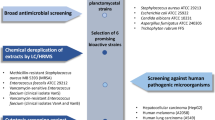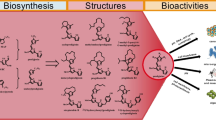Abstract
Liamocins are structurally unique, heavier-than-water “oils” produced by certain strains of Aureobasidium pullulans. The aim of the current study is to identify new sources of liamocins and evaluate their potential as anticancer agents. Nine strains of A. pullulans from phylogenetic clades 8, 9, and 11 were examined for the first time for production of liamocins. Strains in these clades have only been isolated from tropical environments, and all strains tested here were from various locations in Thailand. Strains RSU 9, RSU 21, and RSU 29, all from clade 11, produced from 7.0 to 8.6 g liamocins/l from medium containing 5 % sucrose. These are the highest yields of liamocins that we have found thus far. These strains also produced from 9.4 to 17 g pullulan/l. The structural identity of liamocins was confirmed by matrix-assisted laser desorption/ionization mass spectrometry; differential spectra were obtained in which the dominant ion was either at about m/z 805.5 or m/z 949.6, consistent with the structure of liamocins. Liamocins from A. pullulans strains RSU 9 and RSU 21 inhibited two human breast cancer cell lines and a human cervical cancer cell line (IC50 values of 32.2 ± 1.4 to 63.1 ± 2.4 μg liamocins/ml) but were not toxic to a normal cell line. Liamocins weakly inhibited a strain of Enterococcus faecalis, but did not inhibit strains of Lactobacillus fermentum, Staphylococcus aureus, Escherichia coli, and Pseudomonas aeruginosa. Thus, A. pullulans phylogenetic clade 11 is a promising source of liamocins, and these compounds merit further examination as potential anticancer agents.


Similar content being viewed by others
References
Berrington D, Lall N (2012) Anticancer activity of certain herbs and spices on the cervical epithelial carcinoma (HeLa) cell line. Evid Based Complement Altern Med 2012:564927
Doshida J, Hasegawa H, Onuki H, Shimidzu N (1996) Exophilin A, a new antibiotic from a marine microorganism Exophiala pisciphila. J Antibiot (Tokyo) 49:1105–1109
Hibbett DS, Binder M, Bischoff JF et al (2007) A higher-level phylogenetic classification of the Fungi. Mycol Res 111:509–547
Isoda H, Nakahara T (1997) Antiproliferative effect of polyol lipids, 3,5-dihydroxydecanoyl and 5-hydroxy-2-decenoyl esters of arabitol and mannitol on lung cancer cell line A549. J Ferment Bioeng 84:403–406
Isoda H, Kitamoto D, Shinmoto H, Matsumura M, Nakahara T (1997) Microbial extracellular glycolipid induction of differentiation and inhibition of the protein kinase C activity of human promyelocytic leukemia cell line HL60. Biosci Biotech Biochem 61:609–614
Kurosawa T, Sakai K, Nakahara T, Oshima Y, Tabuchi T (1994) Extracellular accumulation of the polyol lipids, 3,5-dihydroxydecanoyl and 5-hydroxy-2-decenoyl esters of arabitol and mannitol, by Aureobasidium sp. Biosci Biotech Biochem 58:2057–2060
Leathers TD (1989) Purification and properties of xylanase from Aureobasidium. J Ind Microbiol 4:341–348
Leathers TD (2002) Pullulan. In: Vandamme EJ, De Baets S, Steinbüchel A (eds) Biopolymers, vol 6., Polysaccharides II: polysaccharides from eukaryotesWiley, Weinheim, pp 1–35
Manitchotpisit P, Leathers TD, Peterson SW, Kurtzman CP, Li X-L, Eveleigh DE, Lotrakul P, Prasongsuk S, Dunlap CA, Vermillion KE, Punnapayak H (2009) Multilocus phylogenetic analyses, pullulan production and xylanase activity of tropical isolates of Aureobasidium pullulans. Mycol Res 113:1107–1120
Manitchotpisit P, Price NPJ, Leathers TD, Punnapayak H (2011) Heavy oils produced by Aureobasidium pullulans. Biotechnol Lett 33:1151–1157
Manitchotpisit P, Skory CD, Peterson SW, Price NPJ, Vermillion KE, Leathers TD (2012) Poly(β-l-malic acid) production by diverse phylogenetic clades of Aureobasidium pullulans. J Ind Microbiol Biotechnol 39:125–132
Mosmann T (1983) Rapid colorimetric assay for cellular growth and survival: application to proliferation and cytotoxicity assays. J Immun Methods 65:55–63
Nagata N, Nakahara T, Tabuchi T (1993) Fermentative production of poly(β-L-malic acid), a polyelectrolytic biopolyester, by Aureobasidium sp. Biosci Biotechnol Biochem 57:638–642
National Committee for Clinical Laboratory Standards (1999) Performance standards for antimicrobial disk and dilution susceptibility tests for bacteria isolated from animals; approved standard (M31-A). National Committee for Clinical Laboratory Standards, Wayne, PA
Price NPJ, Manitchotpisit P, Vermillion KE, Bowman MJ, Leathers TD (2013) Structural characterization of novel extracellular liamocins (mannitol oils) produced by Aureobasidium pullulans strain NRRL 50380. Carbohydr Res 370:24–32
Rahman S, Salehin F, Iqbal A (2011) In vitro antioxidant and anticancer activity of young Zingiber officinale against human breast carcinoma cell lines. BMC Complement Altern Med 11:76
Schoch CL, Shoemaker RA, Seifert KA, Hambleton S, Spatafora JW, Crous PW (2006) A multigene phylogeny of the Dothideomycetes using four nuclear loci. Mycologia 98:1042–1053
Singh RS, Saini GK, Kennedy JF (2008) Pullulan: microbial sources, production and applications. Carbohydr Polym 73:515–531
Acknowledgments
Expert technical assistance was provided by Melinda S. Nunnally.
Author information
Authors and Affiliations
Corresponding author
Additional information
Mention of any trade names or commercial products in this publication is solely for the purpose of providing specific information and does not imply recommendation or endorsement by the US Department of Agriculture. USDA is an equal opportunity provider and employer.
Rights and permissions
About this article
Cite this article
Manitchotpisit, P., Watanapoksin, R., Price, N.P.J. et al. Aureobasidium pullulans as a source of liamocins (heavy oils) with anticancer activity. World J Microbiol Biotechnol 30, 2199–2204 (2014). https://doi.org/10.1007/s11274-014-1639-7
Received:
Accepted:
Published:
Issue Date:
DOI: https://doi.org/10.1007/s11274-014-1639-7




